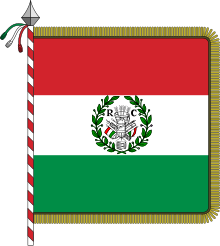Cispadan Republic
The Cispadan Republic (contemporary spelling; next to it modern Zispadanische Republik ; Italian Repubblica Cispadana ) was an Italian subsidiary republic established by French revolutionary exports , which was formed from the cities of Modena , Reggio , Ferrara and Bologna and their surroundings. It was constituted on December 27, 1796, but dissolved again on July 9, 1797 when it joined the Cisalpine Republic .
General Bonaparte's troops had penetrated during the First Coalition War in February 1796 via the northern Italian main river Po to the Papal States and largely led to the dissolution of the previous feudal structures ; in the Duchy of Modena , bordering on the Papal States, the local republicans drove out the old government in August 1796 . The cities of Modena and Reggio (both formerly the Duchy of Modena) as well as Bologna and Ferrara (both formerly legations of the Papal States) declared themselves to be small republics and formed a federation (Federazione Cispadana) in mid-October 1796 . The actual establishment of a state based on the model of the French directory system took place at the congress in Reggio from December 27, 1796 to January 9, 1797, at which the representatives of these cities met. However, Bologna and Ferrara announced as early as the following February that they wanted to join the neighboring Trans-Padan sister republic, separated only by the Po , when the connection between the two states had been secured by the fall of the last Austrian fortress, Mantua . After the Transpadan Republic reformed to the Cisalpine Republic on June 29, 1797, the rest of the Cispadan Republic dissolved shortly thereafter and joined it on July 9, 1797 as well.
Remarks
- The state name is derived from the Latin words cis for this side and Padus for the Po: The Cispadan Republic was the republic this side of the Po , seen from an Italian point of view. Emperor Augustus had already established a territorially corresponding region called (Gallia) Cispadana .
- At the fourteenth session of the Cispadan Congress on January 7, 1797, with the assembled hundred delegates from Bologna, Ferrara, Modena and Reggio Emilia, Joseph Compagnoni from Lugo proposed that the cispadan tricolor of the colors green, white and red should be used in general, especially as a version for the cispadan sleeve band that should be worn by everyone. The proposal was accepted by Congress. On the horizontally striped Cispadan flag was an emblem made of military elements from January 2, 1797, including a quiver in which four arrows symbolized the founding cities of the republic. A 5th arrow (for Massa-Carrara ) was proposed on January 25, 1797 , but it is not known whether this was added to the emblem. The flag was in use until May 19, 1797. The Italian racing cyclist Paolo Bettini carried the cispadan flag on the podium when he won the road world championships in Salzburg 2006 and Stuttgart 2007. The tricolor of Cispadania is considered to be the first national flag of Italy and in a modified form ( vertical stripes) became the flag of today's Italian state.

